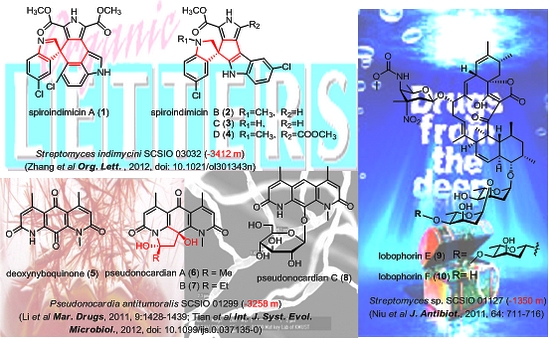Discovery of New Secondary Metabolites from Deep-Sea-Derived Actinomycetes
Recently, researchers of LMB in the South China Sea Institute of Oceanology made progresses on discovering new secondary metabolites from deep sea microbes. The recent discovery was published in Organic Letters (2012, 14: 3364-3367).
The team led by Changsheng Zhang has been working on 3 deep-sea-derived actinomyetes (provided by Dr. Xinpeng Tian): Streptomyces indimycini SCSIO 03032 (sp. nov., isolated from a sediment sample of 3412 m in depth from the Indian Ocean), Pseudonocardia antitumoralis SCSIO 01299 (sp. nov., isolated from a sediment sample of 3258 m in depth from the South China Sea, Tian et al, Int. J. Syst. Evol. Microbiol., 2012, doi: 10.1099/ijs.0.037135-0. New species), and Streptomyces sp. SCSIO 01127 (isolated from a sediment sample of 1350 m in depth from the South China Sea). Nine novel bioactive compounds were discovered from these 3 deep sea-dervied actinomycetal strains. A PCR-based screening approach facilitated the identification of a deep-sea-derived Streptomyces sp. SCSIO 03032 capable of producing four new bisindole alkaloids spiroindimicins A–D (1–4) with unique [5,6] or [5,5] spiro-ring skeleton (Zhang et al, Org. Lett., 2012, 14: 3364-3367). Spiroindimicins B-D (2-4) with [5,5] spiro-ring displayed moderate antitumor activities. The compound deoxynyboquinone (5) and three new diazaquinone derivatives pseudonocardians A-C (6-8) were isolated from strain SCSIO 01299(Li et al, Mar. Drugs, 2011, 9: 1428-1439 and showed strong antibacterial (MIC 1–4 μg/ml) and antitumor (IC50 0.01 - 0.21 μM) activities. Two new macrolides lobophorins E (9) and F (10) from SCSIO 01127 exhibited better antibacterial activity than their parent compound lobophorin A (Niu et al, J. Antibiot., 2011, 64: 711-716).
These new discoveries attracted international attentions. “The few bioactive compound screening studies reported to date on deep-sea actinomycetes have yielded extraordinary results”, Prof. Lutz and Falkowski of Rutgers University (USA) pointed out in a Perspective “A Dive to Challenger Deep” (Science, 2012, 336: 301-302). Our results imply that deep-sea-dervied actinomycetes are of great potential for new compounds and deserve further explorations.
